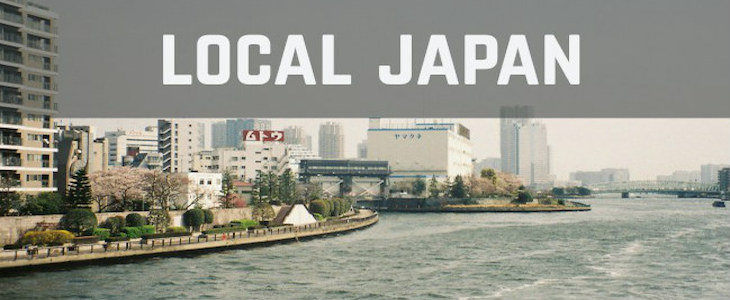
Local Japan: Koto ward – at home in Tokyo’s shitamachi
Koto Ward is the sweet spot of Tokyo. It’s just far enough from the city center to be relaxed and quiet, just close enough to make going out quick and effortless. Biking directly west of my postage-stamp-sized apartment, I cross the Arakawa River, which winds from Saitama into Tokyo Bay, and into sleepy Edogawa Ward perched on the Pacific Ocean. Biking directly east, I cross the Sumida River into Ginza, the center of luxury shopping and small, elegant tucked away restaurants. North is Tokyo Skytree and clusters of cheap bars with herds of office workers winding through the alleys from drink to drink late at night. And biking south, I reach the sea.
That Koto is close to the sea is the only thing I knew when I moved here a year and a half ago. After being accepted into the JET Program, I got an email telling me I would be teaching at a high school in the middle of Koto Ward. On Googling the area, I found out almost nothing. Apparently there’s a famous festival in the summer, but I have never been. At that time, there was so little information in English about Koto, and I thought (wrongly) there must not be much to see. I thought maybe it would be like New York, where I lived in a town known for nothing and had to take the train to see anything interesting. In fact, the comparative lack of any famous spots or attractions is what gives Koto its unique draw.
I learned Koto after I moved here, on foot and by bicycle. Almost everything I know has come from wandering around. Coming from New York and having lived in Chicago and Beijing, I’ve always felt that the best way to get to know a city was to walk or bike exhaustively. It’s the places in between the subway stations and bus stops that have the most to offer. The finest parts of the city usually reveal themselves, in my experience, after you’ve turned down several alleys and lost touch with the main street.
I live in one such alley, in what I suspect is the smallest apartment in the building. In fact, I suspect it was a closet recently renovated into an apartment (using a generous interpretation of the word “apartment”). It is comfortable and—most importantly—the first place I can truly call mine, and its size pushes me out the door whenever I have free time. Accompanied by at least 2 cameras, I spend most of my time not at work biking around and stopping in anywhere that looks interesting.
It’s strange to say, but Tokyo is one of the quietest places I’ve ever lived, and one of the friendliest. It’s not that the other cities where I lived weren’t friendly. But walking into any store or restaurant here, as soon as you ask someone one question they’ll tell you everything—the history of the neighborhood, all about their family, things to do in Koto. If you need help, they’ll offer you everything.
I went to the public bath when my electricity was shut off (a late, late bill) and asked the woman, “By the way, if my electricity’s been shut off, how can I get in touch with the company?”
The woman behind the desk told me to wait and ran home to find her own bill receipt, leaving me standing in the lobby of this bath. She wrote down the number and the department to ask for, all the while telling me somewhat conspiratorially, “You might be able to just flip the breaker yourself, you know. Of course call them as well, but I’d try that first.”
The extension of help and tenderness, and the infectious love of our neighborhood, has made me feel at home here much more quickly than I was expecting. In an ambitious city like New York, I feel like I have to prove myself constantly. I have to be doing something that makes me worthy of living in such a place of dreams and legend, a place of pride in its own viciousness.
By contrast, aside from the usual questions of where I come from and why I’m living in Japan, people in Koto seem to feel most at home in the present, rather than future achievements.
Many of the people I’ve spoken to have identified this as a characteristic spirit of this part of Tokyo, known as Shitamachi. “Classic Shitamachi,” they say. “These are good people, around here. Good Shitamachi people.” There’s pride, but it’s pride in a warmth of character.
In fact, there’s not much to do Koto. There aren’t many sightseeing places—just good places to spend time with people you care about. My love of this particular neighborhood is inextricably tied to the people I share it with—Shitamachi natives and people I work with who commute from other parts of the city. If I were to walk from one end of the ward to the other, I could chart the whole web of relationships I’ve been lucky enough to make while living here for such a short time.
From the Arakawa River, there’s the spot where I watch the fireworks festival in the summer with my friends. Just inland from that is the Chinese restaurant where I used to go when I couldn’t speak any Japanese and could talk to the owners in Chinese, where they would make me tea every time I came in and we’d trace our respective family histories. Their families were scattered between China and Japan, all across both countries, and mine sprawls over America, with me as the errant satellite abroad.
Beyond that, moving west, are all the little bars I never would have found on my own that I go to with coworkers—all the cafes and restaurants we go to when we look at each other across our desks and go, “Let’s get out of this office for a bit.” These have been the most important sites for strengthening my sense of belonging, and I can no longer pass a particular bar without thinking, “This is the place where me and another English teacher decided to go to Taiwan together” or “There’s the spot where I lost a game of rock-paper-scissors with the ethics teacher and had to eat the last tuna roll covered in a mound of wasabi.”
There’s the public bath with the woman who helped me with my electricity bill, and the public library where the sweetest older ladies work. And every park that has hosted countless picnics and cherry blossom viewing parties. The convenience store that I go to every morning where one of the cashiers sometimes speaks English with me, methodically picking out each word while I slowly count out exact change.
There are too many places to list, but each one links up in my mind to a bright chain across Koto of everyone who extended some degree of kindness, everyone who I spent even an hour with, everyone who made me laugh. This is something I don’t have in New York or Beijing, where everything is in constant upheaval and no one can afford to slow down for even a minute.
Koto is also a place to be solitary, comfortably. I work until 8 at night and when I go home at night, I see at most two dozen people. In the neighborhood around my house, I see even fewer. Often at night, I jog through little alleys and small streets and don’t see a single person except, perhaps, for an old man smoking on the veranda of his shuttered home.
It’s this quiet that I like the best. Koto never feels dead, or like there’s nothing to do. It’s just quiet. At peace with itself. It’s a place where you can stop and unfurl your whole self, letting your thoughts wander as far as your feet can carry you, walking from the sea up to Kameido, through all the little market streets and around residential pockets.
Koto is the perfect place to be based, to jump off into other parts of the city. It’s a slim peninsula with countless bridges branching out into other wards, drawing all the life in Tokyo through its borders. From the bridge near my house, you can see both Skytree and Tokyo Tower, and from that bridge it feels like you can see the entirety of the city.
Rather than being part of the image of the perfect tourist destination that Tokyo ambitiously projects for the 2020 Olympics, Koto is the place from which to watch the rest of the city, while you grow your own roots, linking up with all the good Shitamachi people living their own quiet lives.



